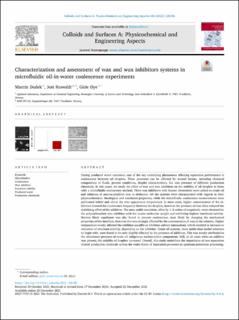| dc.description.abstract | During produced water treatment, one of the key underlying phenomena affecting separation performance is coalescence between oil droplets. These processes can be affected by several factors, including chemical composition of fluids, process conditions, droplet characteristics, but also presence of different production chemicals. In this paper, we study the effect of wax and wax inhibitors on the stability of oil droplets in brine with a microfluidic coalescence method. Three wax inhibitors with known chemistries were added to crude oil and solutions of macrocrystalline wax in dodecane. All the systems were characterized with regards to their physicochemical, rheological and interfacial properties, while the microfluidic coalescence measurements were performed below and above the wax appearance temperature. In most cases, higher concentration of the inhibitors lowered the coalescence frequency between the droplets, however the presence of wax often reduced the stabilizing effect of the additives. The most stable emulsions, often by 1–2 orders of magnitude, were obtained for the polycarboxylate wax inhibitor with the lowest molecular weight and exhibiting highest interfacial activity. Styrene block copolymer was also found to prevent coalescence, most likely by changing the mechanical properties of the interface, however this was strongly affected by the concentration of wax in the solution. Higher temperature mostly affected the inhibitor-paraffin or inhibitor-solvent interactions, which resulted in increase or reduction of emulsion stability, depending on the inhibitor. Crude oil systems, more stable than model solutions to begin with, were found to be only slightly affected by the presence of additives. This was mostly attributed to the abundance presence of crude oil indigenous surface-active components. Still, in all cases when an additive was present, the stability of droplets increased. Overall, this study underlines the importance of non-separation related production chemicals within the wider frame of separation processes in upstream petroleum processing. | en_US |

